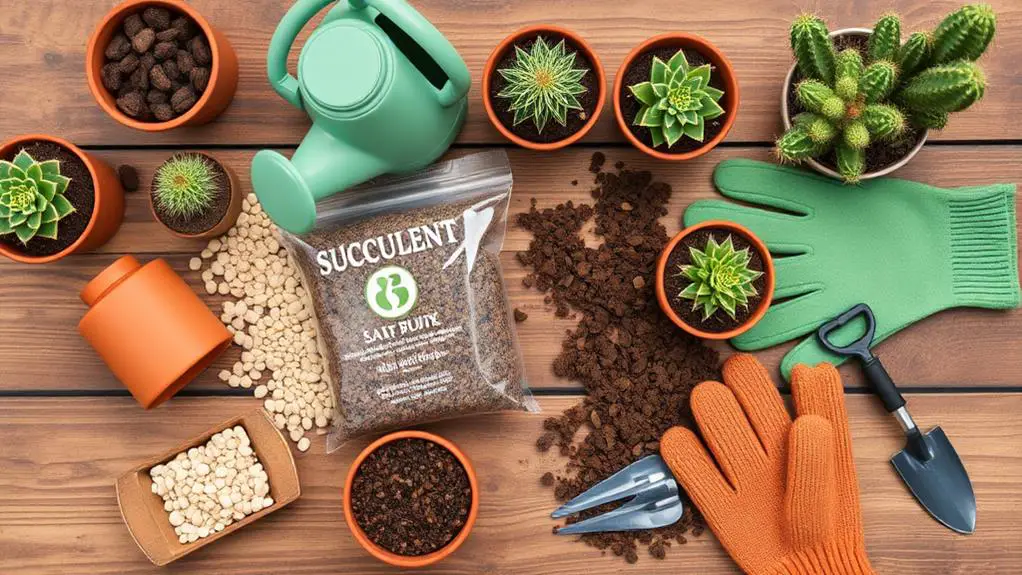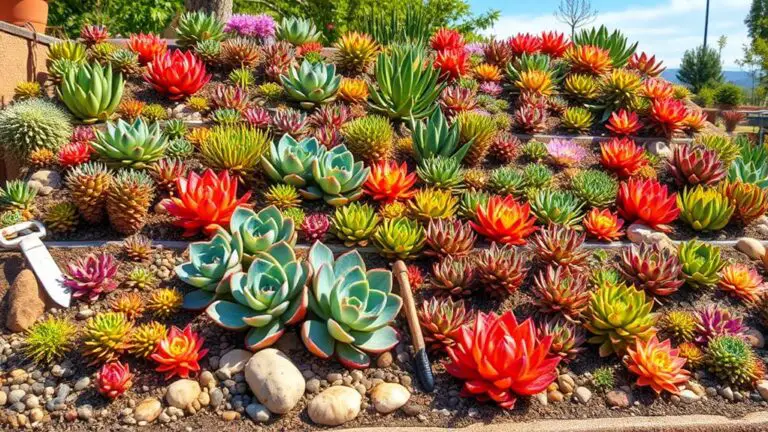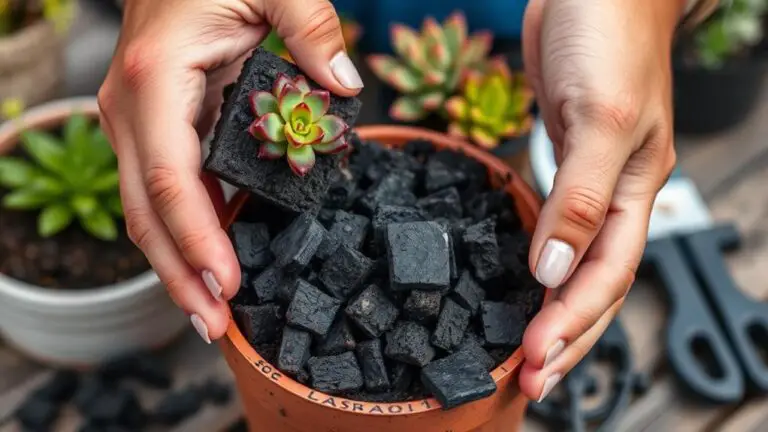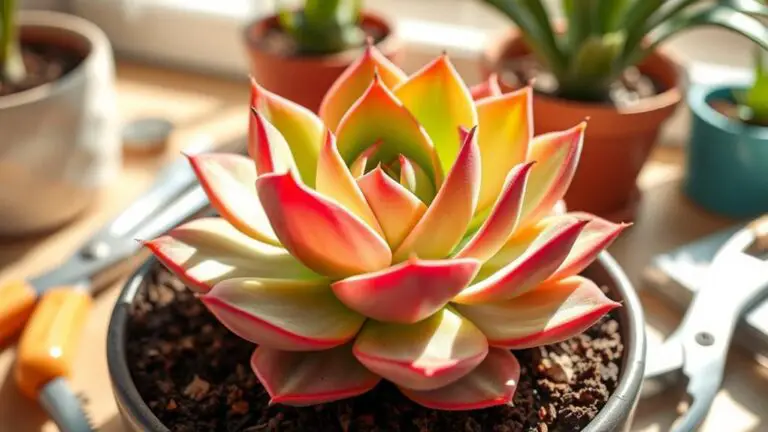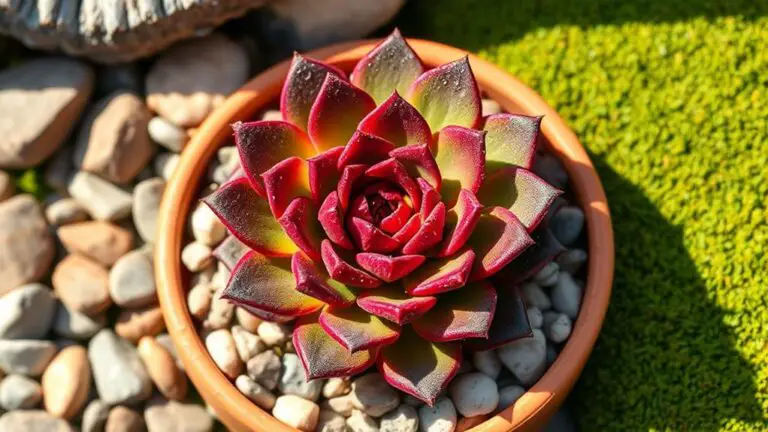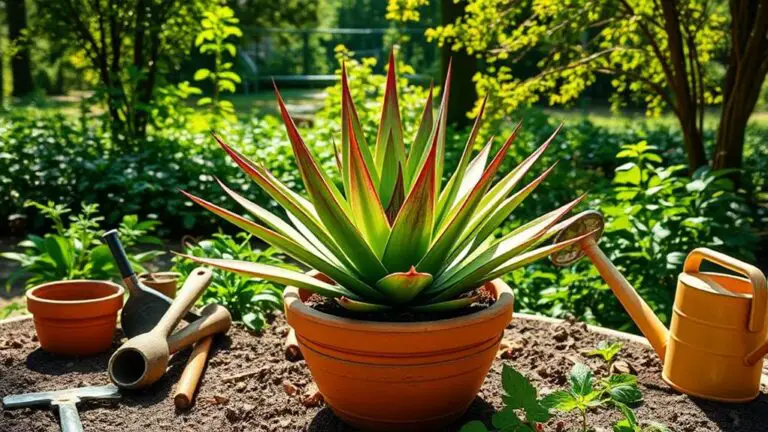7 Essential Supplies for Planting Succulents
When you're planting succulents, selecting the right supplies can make all the difference in their health and growth. You'll need containers with drainage holes, ensuring excess water doesn't harm the roots. Choosing the right soil mix is also vital; a specially formulated succulent soil provides the proper drainage and nutrients. Don't forget essential planting tools like shovels and tweezers for easy handling. But that's not all—there are a few more items that you might not have considered yet, which can greatly impact your succulents' well-being.
Succulents
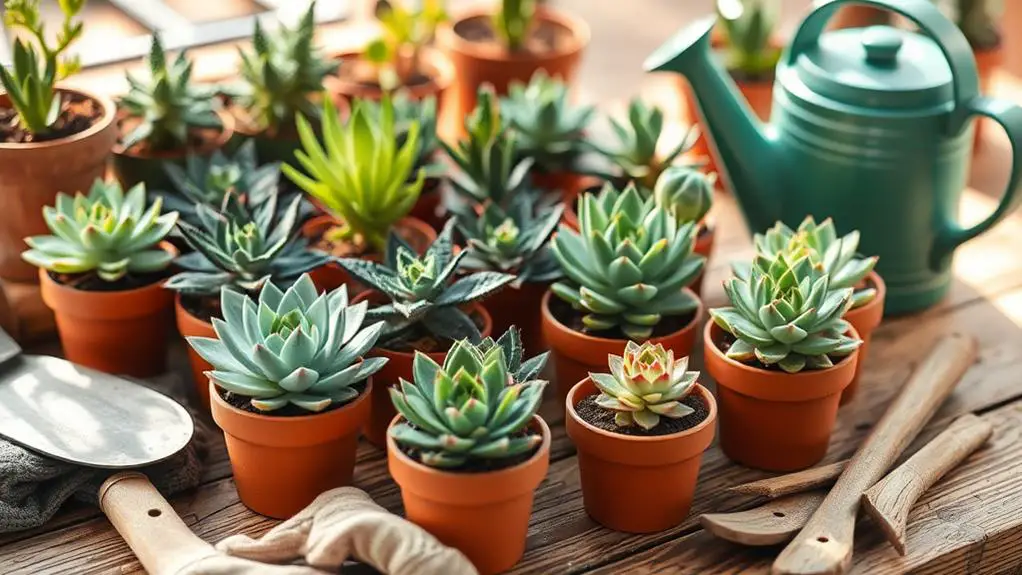
Understanding succulents can transform your approach to low-maintenance gardening. Succulent plants are perfect for those seeking beautiful greenery without the fuss. These drought-resistant wonders store water in their leaves, so they can go longer without watering. You'll find thousands of species, like Echeveria, Haworthia, and Aloe, each with unique shapes and colors to brighten any space.
When planting succulents, the soil you choose is vital. Regular garden soil won't do; you need a well-draining mix, usually labeled as succulent or cactus soil. This specialized soil prevents root rot by allowing excess water to escape quickly. Drainage holes in your pots are essential for this reason.
To get started, gather your succulent tools. You'll need a small trowel or spoon for planting, and perhaps tweezers for handling delicate plants. Place your succulent in the pot, fill it with soil, and gently press down to remove air pockets.
Succulents thrive in bright, indirect sunlight. Gradually introduce them to direct sun to avoid sunburn. Let the soil dry out completely between waterings to mimic their natural environments.
With these tips, your succulents will flourish with minimal effort.
Containers With Drainage

Selecting the right containers with drainage is essential for keeping your succulents healthy. Containers with drainage holes prevent excess water from accumulating at the bottom, which can cause root rot. When you're choosing a container, make sure it has at least one drainage hole. This helps water escape easily after you water your succulents, so the soil doesn't stay too wet for too long.
Using containers without drainage can increase the risk of overwatering. Succulents don't like to sit in soggy soil, and too much moisture can be harmful. That's why terracotta pots are a popular choice for succulent potting. Terracotta pots are porous, which means they allow air to circulate and moisture to evaporate more easily. This can help keep the roots of your succulents dry and healthy.
To enhance drainage even further, consider adding a layer of pebbles or gravel at the bottom of the container before you add the soil. This extra layer helps prevent water from pooling around the roots.
Mesh Tape

Mesh tape is a handy tool for succulent enthusiasts, helping to cover drainage holes in containers effectively. When you're planting succulents, it's essential to guarantee that water can drain properly to maintain ideal soil moisture.
Mesh tape does just that by covering those drainage holes, preventing soil loss while still allowing excess water to escape. This is important because succulents don't like sitting in water, which can lead to root rot.
Using mesh tape is simple. Just cut a piece to fit over the drainage hole in your container. It's made from durable materials, so it withstands moisture and pressure, making it a reliable choice for your succulent projects.
Plus, it's cost-effective! A single roll can last through multiple plantings, giving you great value.
Applying mesh tape in your succulent arrangements promotes better drainage. This reduces the risk of overwatering, which is a common problem that can harm your plants.
Succulent Soil
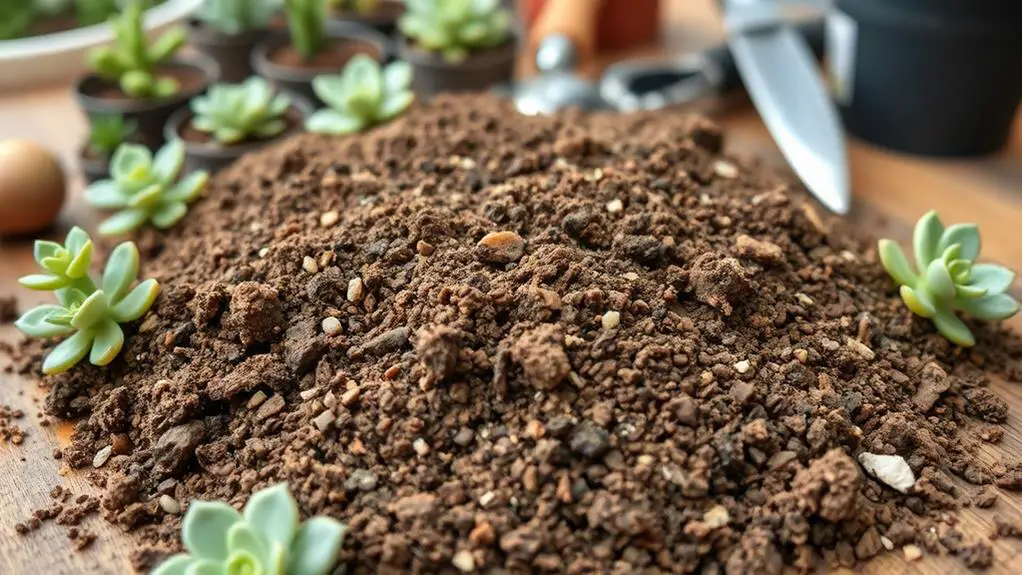
Crafting the perfect environment for your succulents hinges on using the right soil mix. Succulent soil is specifically formulated to provide excellent drainage, which prevents root rot. Regular potting soil holds too much moisture, but succulent soil allows water to flow through easily. This is essential because succulents store water in their leaves and can't handle soggy roots.
An ideal succulent soil mix includes components like perlite, pumice, and coarse sand. These materials enhance aeration and control moisture. Perlite and pumice are volcanic rocks that keep the soil light and airy, ensuring roots don't stay wet for too long.
You can find many commercially available succulent and cactus soil mixes for around $11.99, so they're affordable and easy to use.
For a cost-effective option, you can make your own DIY succulent soil. Just combine equal parts of regular potting soil, coarse sand, and perlite or pumice. This mix will provide the drainage and aeration your succulents need.
Remember to replace the soil every couple of years to replenish nutrients and maintain ideal conditions. With the right succulent soil, your plants will thrive and look their best.
Planting Tools
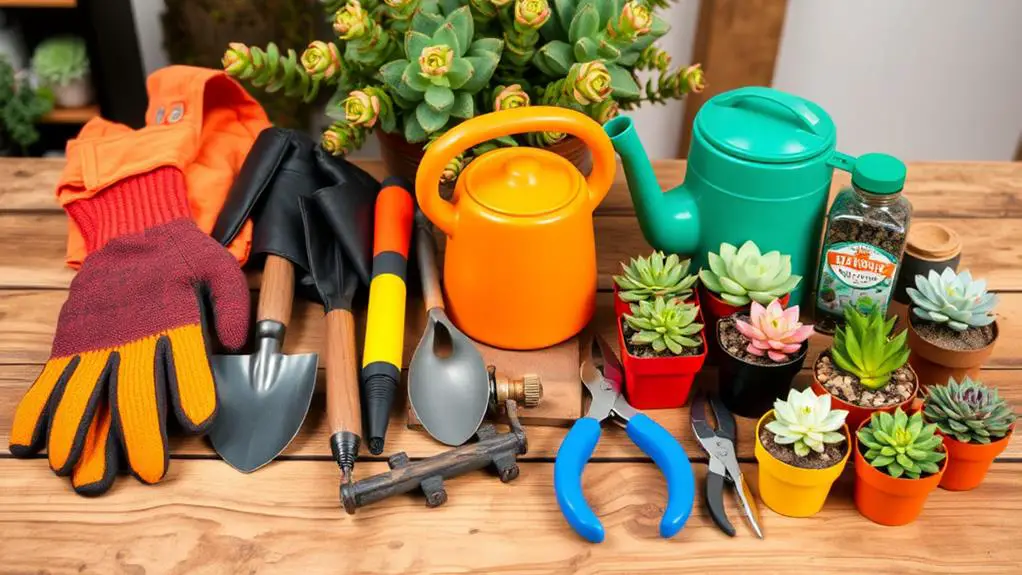
Let's talk about the essential planting tools you'll need for your succulents.
Basic tools like a shovel, tweezers, and pruning shears will make planting and caring for your succulents a breeze.
Don't forget specialized tools like a moisture meter and mini scoops, which can help you guarantee your plants are well-hydrated and efficiently transfer soil.
Basic Planting Tools
When it comes to planting succulents, having the right tools can make all the difference. A succulent tool kit is essential for anyone looking to create a thriving garden. Basic supplies for planting include a shovel, which is perfect for transferring and arranging soil. A bucket shovel is especially useful for efficiently moving soil and mixing components to create the best growing medium for your succulents.
Another must-have is a moisture meter. This tool helps you accurately measure soil hydration, guaranteeing you don't overwater your plants. Overwatering is a common problem, but a moisture meter can help you avoid it.
Pruning shears are also essential for maintaining your succulents' aesthetics. Use them to trim dead or damaged leaves, promoting healthier growth.
Tweezers come in handy for delicate tasks like removing dead leaves without disturbing the roots or safely handling cactus spines. Soft brushes are great for removing dust from succulent leaves, which helps improve photosynthesis and can also be used to eliminate pests like spider mites.
Using high-quality tools specifically designed for succulent care guarantees the best growth conditions and helps prevent common issues. With these tools, you'll be well-equipped to create a beautiful and healthy succulent garden.
Specialized Care Tools
Although basic tools are crucial for planting succulents, specialized care tools elevate your gardening experience by addressing specific needs.
For instance, tweezers are essential for delicate tasks like removing dead leaves, placing small plantlets, and handling cactus spines safely, ensuring you don't damage fragile roots.
When it comes to keeping your plants clean, soft brushes are perfect for dusting off succulent leaves. This enhances photosynthesis and helps remove pests like spider mites and mealybugs. A must-have for succulent care!
To avoid the common mistake of overwatering, a moisture meter is imperative. This tool accurately measures soil moisture levels, ensuring your succulents get just the right amount of water for peak health.
For shaping, trimming, and maintaining your plants, pruning shears with sharp blades are crucial. They allow you to make clean cuts when removing dead leaves or managing plant size, promoting healthy growth through regular maintenance.
Lastly, a bucket shovel proves versatile for transferring soil, mixing components for ideal conditions, and leveling soil in pots. It's a valuable companion when you plant succulents.
Using these specialized care tools will make your succulent gardening more efficient and enjoyable!
Tool Maintenance Tips**
While specialized care tools enhance your succulent gardening experience, maintaining these tools is just as important. Regularly clean your planting tools, like shovels and pruning shears, with soapy water. Disinfect them with rubbing alcohol to prevent spreading diseases between plants. This simple step keeps your succulents healthy.
Store your tools in a dry place after use to avoid rusting and deterioration. This guarantees they're in good condition for your next gardening task.
Sharpen the blades of your pruning shears and other cutting tools periodically. Sharp blades make clean cuts, reducing the risk of damaging your succulent container plants.
Before each use, check for any loose screws or parts on your tools. Tighten them as needed to maintain their functionality and safety. This small act can save you from bigger problems down the line.
After cleaning, apply a light coat of vegetable oil to the metal parts of your tools. This creates a protective barrier against moisture and rust.
Top Dressing
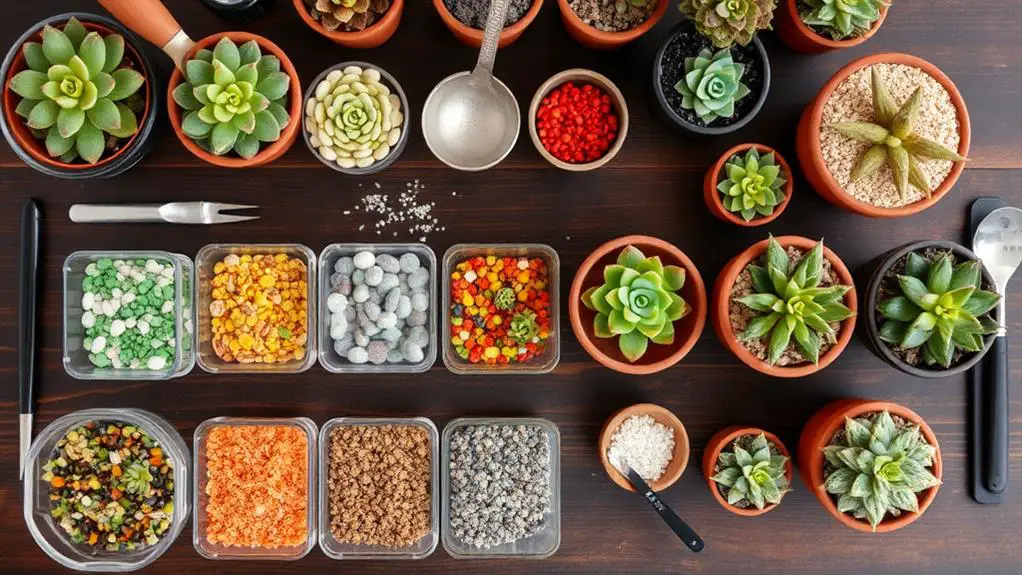
Top dressing plays an essential role in succulent care, enhancing both the visual appeal and functionality of your plant arrangements. By adding decorative rocks or other materials, not only do you make your succulent pots look stunning, but you also help with soil retention. This prevents soil from shifting during watering, ensuring your plants stay in place.
Consider using top dressing to create a polished, professional look for your succulent arrangement. Options like pea gravel, colored sand, or glass gems allow you to customize the design to fit your style. Each material provides a unique aesthetic appeal, making your plants stand out.
Top dressing isn't just about looks. A well-chosen layer can help retain moisture in the soil, which is vital for succulent health. It also keeps the soil tidy and protected, reducing erosion during watering. Make sure to choose materials that allow water to penetrate effectively.
Here are some benefits of using top dressing:
- Enhances the visual appeal of your succulent arrangement
- Prevents soil shifting during watering
- Retains moisture in the soil
- Provides a tidy, polished look
- Reduces soil erosion
Regularly renewing your top dressing keeps your succulent arrangement looking fresh and helps maintain plant health.
Moisture Meter
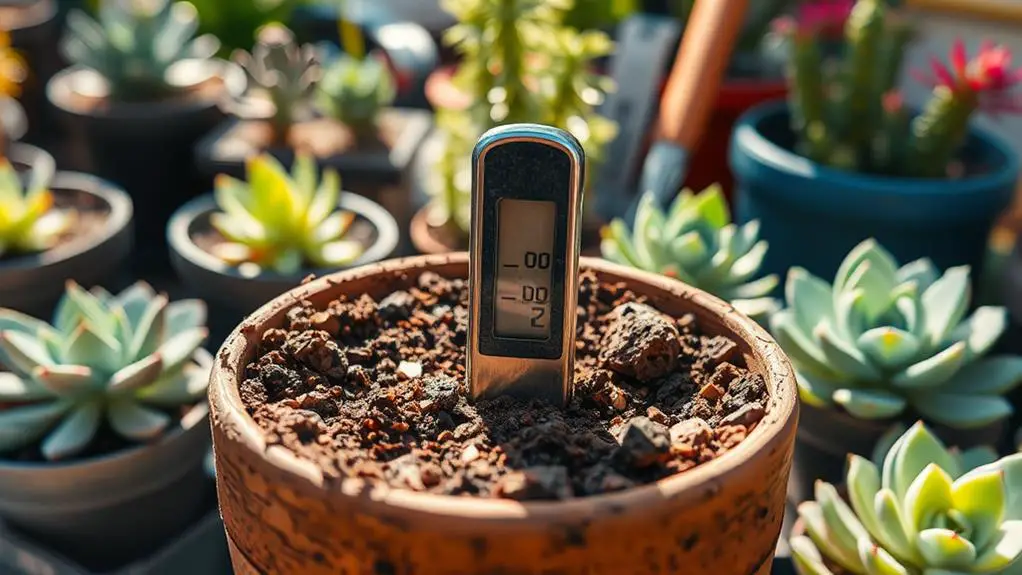
A moisture meter is a must-have tool for succulent enthusiasts, enabling you to accurately gauge soil moisture levels and prevent the common pitfalls of overwatering or underwatering.
It's an essential part of succulent care because it helps you understand exactly when your plants need water. By using a moisture meter, you can determine the ideal hydration needs of each succulent, ensuring they get just the right amount of water for healthy growth.
Many moisture meters come with color-coded readings, making it easy to quickly see if the soil is too dry, just right, or overly wet. This feature is extremely helpful for making the necessary watering adjustments.
Regular use of a moisture meter can also help you spot dehydration risks early, allowing you to water your succulents just in time.
Investing in a quality moisture meter can greatly enhance the overall health of your plants. It aids in maintaining well-draining soil conditions, which are vital for thriving succulent gardens.
Frequently Asked Questions
What Do I Need to Plant My Succulents?
You'll need a container with a drainage hole, succulent soil, mesh tape, a shovel, and tweezers. Don't forget decorative top dressing like rocks or gravel to keep the soil in place and make your arrangement look great.
What Is the Best Material to Plant Succulents In?
The best material to plant succulents in is a well-draining soil mix formulated for succulents and cacti. You can make your own by mixing equal parts of potting soil, perlite, and coarse sand for ideal drainage.
How Do I Prepare My Soil for Succulents?
You should mix equal parts potting soil, coarse sand, and perlite or pumice for great drainage. Add small rocks at the bottom of your container, and always check soil moisture to keep it dry to slightly moist.
What Do Succulent Need for Potting?
For potting succulents, you need a container with a drainage hole, specialized succulent soil, medium-small rocks, and a layer of decorative rocks. Use mesh tape or a drainage screen to keep soil in place during watering.
Conclusion
With the right supplies, you're set to create a perfect home for your succulents. Remember to choose containers with drainage, use mesh tape, and fill with succulent soil. Don't forget your planting tools, top dressing, and a moisture meter to keep everything in check. You've got all you need to help your succulents thrive. Happy planting, and enjoy watching your little green friends grow! You're well on your way to becoming a succulent expert.

